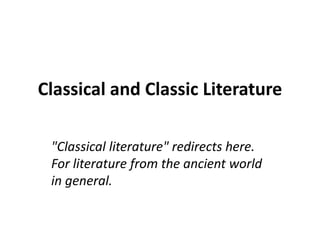
Classical and classic literature
- 1. Classical and Classic Literature "Classical literature" redirects here. For literature from the ancient world in general.
- 2. Etymology The word classics is derived from the Latin adjective classicus, meaning "belonging to the highest class of citizens." The word was originally used to describe the members of the highest class in ancient Rome. By the 2nd century AD the word was used in literary criticism to describe writers of the highest quality.[1] For example, Aulus Gellius, in his Attic Nights, contrasts "classicus" and "proletarius" writers. By the 6th century AD, the word had acquired a second meaning, referring to pupils at a school. Thus, the two modern meanings of the word, referring both to literature considered to be of the highest quality, and to the standard texts used as part of a curriculum, both derive from Roman use.
- 3. Classics or classical studies is the study of classical antiquity, and in the Western world traditionally refers to the study of Classical Greek and Roman literature in their original languages of Ancient Greek and Latin, respectively. It may also include Greco-Roman philosophy, history, and archaeology as secondary subjects. In Western civilization, the study of the Greek and Roman classics was traditionally considered to be the foundation of the humanities, and study of classics has therefore traditionally been the cornerstone of a typical elite European education.
- 4. Some scholars and writers use the terms "classical" and "classic" interchangeably when it comes to literature. However, each term actually has a separate meaning. The list of books that are considered classical versus classic books differs greatly. What confuses things further is that classical books are also classic. A work of classical literature refers only to ancient Greek and Roman works, while classics are great works of literature throughout the ages.
- 5. What Is Classic Literature? Classic literature is a term most readers are probably familiar with. The term covers a much wider array of works than classical literature. Older books that retain their popularity are almost always considered to be among the classics. This means that the ancient Greek and Roman authors of classical literature fall into this category as well. It's not just age that makes a book a classic, however. Books that have a timeless quality are considered to be in this category. While determining if a book is well-written or not is a subjective endeavor, it is generally agreed that classics have high-quality prose.
- 6. What Makes a Book a Classic? While most people are referring to literary fiction when they refer to the classics, each genre and category of literature has its own classics. For example, the average reader might not consider Steven King's novel "The Shining," the story of a haunted hotel, to be a classic, but those who study the horror genre may. Even within genres or literary movements, books that are considered classic are those that are well-written and/or have cultural importance. A book that may not have the best writing but was the first book in a genre to do something ground-breaking is a classic. For example, the first romance novel that took place in a historic setting is culturally significant to the romance genre.
- 7. 3rd Millennium BCE Hymns, codes, instructions and laments (Sumerian) 3rd Millennium BCE Pyramid and coffin texts (Egyptian) 20th Century BCE Original version of “The Epic of Gilgamesh” (Sumerian) 20th Century BCE “The Story of Sinuhe” (Egyptian) 18th Century BCE “Enuma Elis”, “Atra-Hasis” and “Eridu Genesis” (Babylonian/Akkadian) 16th Century BCE “Egyptian Book of the Dead” (Egypt) 16th – 11th Century BCE “Rigveda” (Indian/Sanskrit) 11th Century BCE “The Tale of Two Brothers” and “The Story of Wenamun” (Egypt) 11th – 9th Century BCE “Yajurveda”, “Samaveda” and “Atharvaveda” (Sanskrit/Indian) 11th – 6th Century BCE “Avesta” of Zoroastrianism (Avestan/Persian) 9th Century BCE “I Ching” manual of divination (China) 9th – 7th Century BCE “Brahmanas” and the early “Upanishads” (Sanskrit/Indian) 9th – 6th Century BCE Older parts of the “Old Testament” of the “Bible”, including the “Torah”(Hebrew) 8th Century BCE Epic poems “The Iliad” and “The Odyssey” of Homer and other Trojan War epic poems (Greek) 8th Century B Timeline – Classical Literature
- 8. 8th Century BCE Didactic poetry of Hesiod, including “Theogony” (Greek) 8th Century BCE “Mahabharata” of Vyasa (Sanskrit/Indian) 7th – 6th Century BCE Lyric poems of Sappho (Greek) 6th Century BCE “Fables” of Aesop (Greek) 6th – 5th Century BCE “Four Books” of Confucius (Chinese) 5th Century BCE Lyric poems and odes of Pindar (Greek) 5th Century BCE Tragic plays of Aeschylus, including “The Oresteia” and “The Persians”(Greek) 5th Century BCE Tragic plays of Sophocles, including “Antigone” and “Oedipus the King”(Greek) 5th Century BCE Tragic plays of Euripides, including “Medea”, “The Trojan Women” and “The Bacchae” (Greek) 5th – 4th Century BCE Comic plays of Aristophanes including “The Wasps”, “Lysistrata” and “The Frogs” (Greek) 4th Century BCE “Ramayana” of Valmiki (Sanskrit/Indian) 4th – 3rd Century BCE Comic plays of Menander (Greek) 3rd Century BCE Epic poetry of Apollonius of Rhodes including The Argonautica (Greek) 2nd Century BCE Comic plays of Plautus and Terence(Latin/Roman)
- 9. 1st Century BCE Lyric and elegiac poetry of Catullus (Latin/Roman) 1st Century BCE Epic and didactic poetry of Vergil, including “The Aeneid” (Latin/Roman) 1st Century BCE Lyric poetry and satires of Horace (Latin/Roman) 1st Century BCE – 1st Century CE Didactic, elegiac and epic poetry of Ovid, including “Metamorphoses”(Latin/Roman) 1st Century CE Tragic plays and satires of Seneca the Younger (Latin/Roman) 1st Century CE Epic poetry of Lucan (Latin/Roman) 1st – 2nd Century CE Satires of Juvenal (Latin/Roman) 1st – 2nd Century CE Letters of Pliny the Younger (Latin/Roman) 1st – 2nd Century CE New Testament of the Christian “Bible” (Greek) 7th Century CE “Caedmon’s Hymn” (Old English/Anglo-Saxon) 7th Century CE Traditional date for Islamic “Qur’an” (Arabic) 8th Century CE Epic poem “Beowulf” (Anglo-Saxon)